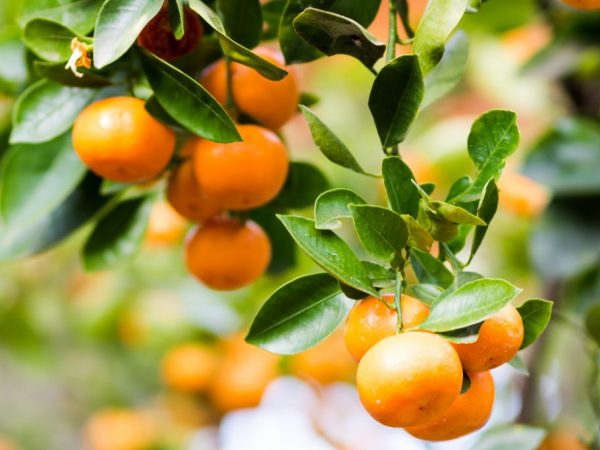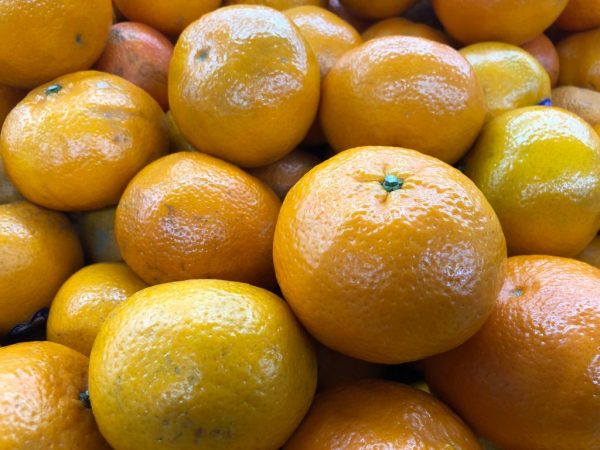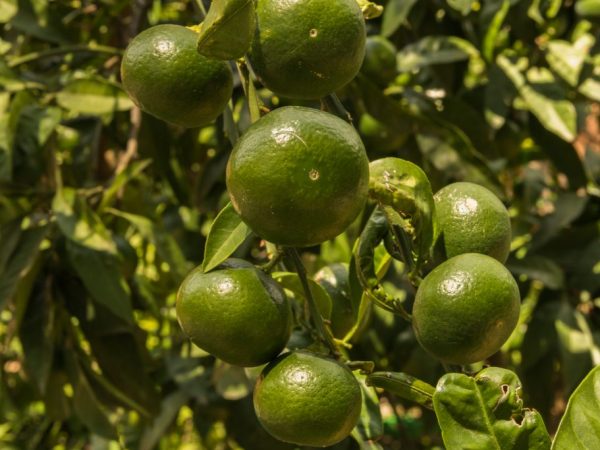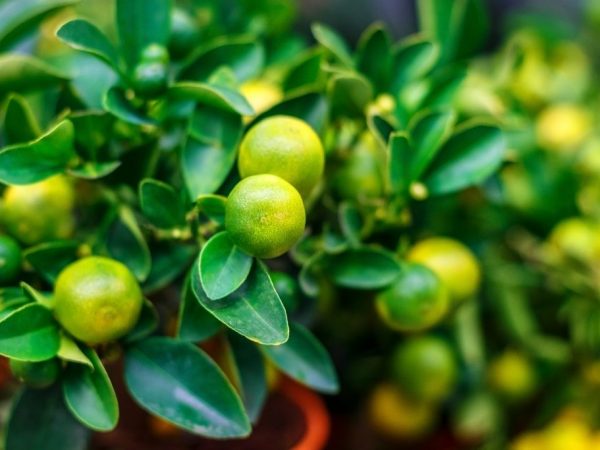Modern varieties of tangerines
Mandarins are citrus fruits. Their fruits are tasty, with a pleasant sourness. Numerous varieties of tangerines have been bred in different countries. It is harvested from October to early June, so the stores sell fruit all year round.

Modern varieties of tangerines
Mandarin description
Several species and hybrids with similar characteristics are called tangerines. Trees grow in tropical and subtropical zones. They reach a height of 4-5 m, and the diameter of the crown is 3-3.5 m. The leaves are small, with pointed tips, fall off every 4 years. The flowers are white, single or double, and have a pleasant aroma.
The fruits are small (except for some hybrids). The shape is rounded, flattened, elongated fruits are less common. The skin can be easily removed. There are 7-8 lobules inside, separated by a thin film. The size and number of seeds depends on the variety. The taste is sweet with sourness.
The plant is self-pollinated, making it easier to create new varieties. Reproduction takes place either by seeds or seedlings. The crop is obtained within 3-4 years after planting. In temperate climates, it is easy to grow homemade citrus in a pot, it even bears fruit in an apartment. But the fruits are not as sweet as in hot countries.
Classification of varieties
Mandarins have species and varieties, and a variety of hybrids are also bred. They are divided by region of origin, production method, color, etc.
The main species groups:
- Noble ones. They are thermophilic, have large leaves and large fruits. Their skin is bright orange and bumpy.
- Tangerines (Italian). Trees with small leaves, medium oval fruits, thermophilic. The skin is bright orange or yellow, thin, with a pronounced aroma.
- Satsuma or unshiu. Winter-hardy trees that can withstand frosts down to -10⁰С. Fruits are light orange, sometimes with green spots. The skin is thin. This species is sometimes called Japanese, from which the famous Abkhaz tangerines originated.
Scientific classification
It is customary to divide into 7 pomological groups:
- Citrus unshiu. The dwarf yellow mandarin Satsuma or unshiu, which is good for temperate climates, is native to Japan. On its basis, many varieties and hybrids have been bred. The average weight of fruits is 50-70 g, their main advantage is the absence of seeds. These tangerines are grown by Georgia, Abkhazia, they are popular in Azerbaijan, Crimea.
- Citrus austere. The sweetest and most delicious Chinese mandarin with a bright orange peel and pulp. It belongs to a separate species. In Europe, the citrus fruit is known as Italian or Sicilian tangerine. Widely cultivated in the USA.
- Citrus deliciosa. A group of Sino-Mediterranean varieties. Its characteristics are similar to the previous one. Often the species is grown in tubs, like a home bush.
- Citrus reticulate. Sino-Indian group. Grows in Taiwan, Philippines, popular in Brazil.
- Citrus nobilis. An Indian-Malay group, popular in Southeast Asia.These are large, bumpy citruses with thick skin and sweet flesh, they are also called noble ones.
- Sino-Japanese group. Small tangerines growing on bonsai. Fruits are often grown at home.
- Hybrids. Mandarins are crossed with almost all citrus fruits. From this they change their size, shape, taste.
Color classification

Red and yellow varieties are widespread in our country.
Classification of varieties of sweet tangerines by color:
- Red
- Yellow
- Green
In our country, the first two are most often found. Greens are not very popular, although there are varieties that combine orange, yellow and green hues.
Red tangerines
The rind is dark orange, almost red in color. The pulp is not much lighter, the taste is sweet, with a slight sourness.
Popular varieties of orange tangerines:
- Clementines. A variety of red tangerines with small flattened fruits. The rind is rich orange, the flesh is juicy and sweet. Are the result of crossing with an orange. In many countries, the variety is a favorite of retail chains.
- Ellendale. The fruits of this fruit are large, with a loose skin of an orange-red hue, the pulp is tasty and aromatic, pitted. They are the product of crossing orange, tangerine and tangerine trees.
- Tangoras or tangelo (tangelo). Belongs to the noble species, bright orange, with bumpy skin, flattened shape. Obtained as a result of crossing with pomelo in vivo. Sometimes this tangerine is called an orange.
- Robinson. A product of American selection, it grows mainly in Florida. Delicious sweet fruits, smooth rind of a rich shade, poorly removable.
- Fruits are medium in size, flattened. The skin is deep orange with a red tint, easily removable. The pulp is juicy, with a rich peculiar taste, a moderate amount of seeds.
- They have a delicate aroma, sweet and sour taste. The skin is thin, poorly cleaned. The variety is obtained by crossing Robinson citrus and Osceola
- Temple or Royal Mandarin. The fruit is sweet, tastes like an orange, with seeds.
- Cleopatra. Comes from India. Now it is bred in the USA, Australia, Spain, and is widely used to develop new hybrids and varieties. The fruits are small, with a thin, orange-red skin, the seeds are large, the taste is sweet.
Red types of tangerines have a good presentation, therefore they are very popular. Many varieties of the group are hybrids; they can belong to different pomological groups.
Yellow and green tangerines

Some varieties will surprise you with color.
Yellow and green tangerines are grown on different continents. To date, many varieties and hybrids of these fruits have been bred. Citrus fruits are often named after their country of origin.
The most popular varieties:
- Turkish. As the name suggests, the country of origin is Turkey. The fruits are small, the skin adheres tightly to the pulp and is difficult to peel. The color is light orange, the taste is sweet and sour, a little bland, there are many seeds in the fruits.
- Moroccan. The skin tone is golden and easy to clean. The pulp is sweet, pitted.
- Chinese. Yellow fruits with a sour taste and juicy pulp, with few seeds. On sale we are rare.
- Israeli tangerines. Medium-sized yellow-orange fruit with sweet and juicy flesh, almost seedless. The peel from the pulp does not separate well, this is the only drawback of the variety.
- Abkhaz. Fruits are sourish, small, with seeds. The peel is yellow, sometimes with a green tint. Descend from a group of Japanese species.
- Georgian. Similar to the Abkhaz, but a little sweeter and larger. Grown in Adjara, near Batumi.
- Serbian. Small, with a thick skin, clean well, but sour. They are rarely found outside the country of cultivation.
- Honey. A hybrid with an orange, with a yellow skin, tasty and juicy pulp.
- Dancy. A popular variety, delicious, sweet and juicy.Unfortunately, trees are susceptible to pests.
- Batangas. Fragrant golden fruit with a delicate taste. The peel is easily separated from the pulp, the bones are small.
- Nadorkott. Refers to tangerines, has a yellow-orange skin and pulp. Trees grow up to 2.5 m in height, begin to bear fruit as early as 1.5 years. The fruits are large, with seeds, juicy pulp and rich taste, the harvest is harvested in March. Suitable for growing at home in containers. This species is cultivated in South Africa.
- Afurer. Similar in characteristics to nadorkotta, but grown in Morocco. It begins to ripen in January. The main advantage is the lack of seeds.
- Green Philippine mandarin. The color of its fruits is unusual, resembles a swamp mud, the skin is bumpy. The pulp is orange, sweet and juicy.
Yellow fruits are popular and are easy to find in any supermarket. Abkhazian, Turkish, Georgian are quite inexpensive. Green citrus fruits are rare as they are grown in the Philippines and surrounding areas. Due to their unusual color, they are less sold, although they taste superior to many other varieties.
Hybrid varieties
Already in the previous sections, some hybrids of red and yellow species were mentioned. Crossbreeding of various tangerines with other citrus fruits is a popular breeding trend. At the same time, large-sized fruits with original taste are obtained. There are hybrids with early ripening periods that are resistant to frost, pests and diseases.
Description of popular tangerine hybrids:
- September. Bred in Sukhumi on the basis of the varieties Unshiu and Poncirus trifoliata, a pioneer of Soviet selection. A tree with a dense crown, flowers with a diameter of 2-3.5 cm. The crop is harvested in September-October. Due to the early maturity, the variety got its name. Fruits are medium, with a thin skin, which is easily separated from the pulp. The taste is sweet and sour, the pulp is juicy.
- Royal mandarin. Country of origin - Pakistan. It is the result of crossing Citrus nobilis and Citrus deliciosa. The variety was improved in 1935 in California. The skin color is yellow-orange, the pulp is juicy, with seeds, the taste is rich and intense.
- Kumquat real. Complex triple hybrid of Fortunella Hindsii kumquat and Montreal clementine. The result is an oblong small tangerine with a sweet and sour rich taste. Like the kumquat, it has a lot of seeds. The fruits are eaten along with the skin. It is possible to grow a bush both outdoors and at home.
- Rangpur. Cross product with lemon. Fruits are small, up to 5 cm in diameter. Taste with characteristic sourness.
- Mineola. A hybrid of Dancy and Duncan grapefruit. The fruits are large, weighing more than 80 g. The peel is red-orange, the pulp is juicy, sweet and sour, contains about 80% of the daily requirement of folic acid.
- A hybrid of mandarin, orange and grapefruit. Sweet and sour fruits, with large fruits, up to 7-8 cm in diameter. The skin is orange-red, thin. The harvest is early, fruits are harvested from September to November.
- Hybrid Clementine and Tangelo Orlando. Grows in arid regions of Arizona and California. Large sweet tangerines weigh about 100 g, the pulp is juicy, the acidity is only 0.7%.
Decorative and homemade tangerines

Growing tangerines is not difficult
The ancestor of ornamental tangerine trees is the wild Japanese dwarf. They are grown in containers or flowerpots. Very little space is needed for such a tree. With proper care, 3-4 kg of citrus fruits can be harvested from one bush.
Popular dwarf varieties:
- Home Pavlovsky. The tree grows up to 1 m high, the flowers are large, up to 3 cm in diameter, fragrant. The fruits are covered with a thin skin, weight about 80 cm, the aroma resembles an orange.
- Anniversary. A hybrid of Miagawa Vasya and an orange, bred in the USSR and intended for home cultivation. The fruit is large, with original warts on the bottom. Ripens early, sweet-sour, aromatic.
- Forged-Vasya.The tree grows up to 50 cm, covered with corrugated foliage. The flowers are small and fragrant. Pear-shaped fruits, with a thin skin, juicy pulp, are well cleaned. 50-70 ripe tangerines are harvested from one bush.
- Calamondin. The calamondin mandarin belongs to a distinct citrus species. He only resembles his relative in form. At home, it grows up to 1 m, has fruits the size of a walnut. Their skin is yellow-green, good taste. Flowers and ripe tangerines on the tree often grow at the same time.
- Emperor. A productive tree that begins to bear fruit in December. The peel on small fruits is plump and easy to clean, the taste is pleasant and sweet.
- Unshiu. Like satsuma, it is the ancestor of indoor species. Forms a low broad-leaved bush, decorative foliage, wavy. The fruit resembles a pear, pitted.
- Imperial. A distinctive feature of the variety, from which it got its name, are large fruits, weighing up to 80 g, with sweet and juicy pulp. Harvested from November.
- Shiva Mikan. The tree is small, blooms profusely. The yield is average, one citrus weighs an average of 50 g.
- Citrofortunella. An original hybrid with Fortunella, grows up to 1.5 m. Abundant and fragrant flowering. The fruits have a pronounced bitterness, therefore citrus is grown as an ornamental bush.
Growing small homemade tangerines is easy. They reproduce by seeds, cuttings and layering. When planting, you should choose a pot with a height of 10-15 cm. As the tree grows, it is transplanted into large containers. For planting, use soil for flowers, such as pelargonialara, rhododendron. There are special mixtures designed specifically for this type of plant.
Conclusion
Citrus loves the sun, that's why they put it on the south window. The room temperature should not fall below 16-18⁰С. In the summer, the pot is taken out into the street, but at night it is better to take it into the house. Water the bush as the soil dries up, sometimes spray the leaves from a spray bottle. Fertilizers are applied during the active growing season. Mixtures for indoor flowers are suitable. If the care is correct, the tree will bear fruit for about 10 years.


